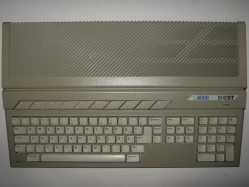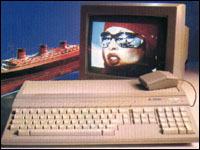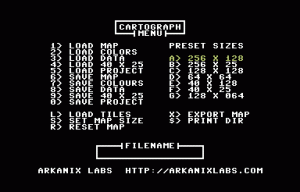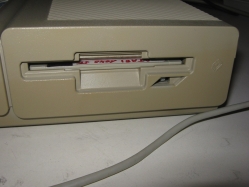
Autopsy:
from Wikipedia:
The Atari ST is a home/personal computer that was commercially available from 1985 to the early 1990s. It was released by Atari Corporation in 1985. The “ST” officially stands for “Sixteen/Thirty-two”, which referred to the Motorola 68000′s 16-bit external bus and 32-bit internals.
The Atari ST was part of the 16/32 bit generation of home computers, based on the Motorola 68000 CPU, with 512 KB of RAM or more, and 3½” single density double sided floppy disks as storage (nominally 720KB). It was similar to other contemporary machines which used the Motorola 68000, the Apple Macintosh and the Commodore Amiga. Although the Macintosh was the first widely available computer with a graphical user interface (GUI), it was limited to a monochromatic display on a smaller built-in monitor.
Preceding the Amiga’s commercial release by almost two months, the Atari ST was the first computer to come with a fully bit-mapped color GUI, using a version of Digital Research’s GEM released that February. It was also the first home computer with integrated MIDI support.
 The ST was primarily a competitor to the Apple Macintosh and the Commodore Amiga systems. This platform rivalry was often reflected by the owners and was most prominent in the Demo Scene. Where the Amiga had custom processors which gave it the edge in the games and video market, the ST was generally cheaper, had a slightly faster CPU, and had a high-resolution monochrome display mode, ideal for business and CAD.
The ST was primarily a competitor to the Apple Macintosh and the Commodore Amiga systems. This platform rivalry was often reflected by the owners and was most prominent in the Demo Scene. Where the Amiga had custom processors which gave it the edge in the games and video market, the ST was generally cheaper, had a slightly faster CPU, and had a high-resolution monochrome display mode, ideal for business and CAD.
Thanks to its built-in MIDI ports it enjoyed success as a music sequencer and controller of musical instruments among amateurs and professionals alike, being used in concert by bands such as Tangerine Dream, Fatboy Slim and 90s UK dance act 808 State. In some markets, particularly Germany, the machine gained a strong foothold as a small business machine for CAD and Desktop publishing work.
The ST was later superseded by the Atari TT and Falcon computers. Since Atari pulled out of the computer market there has been a market for powerful TOS-based machines (clones). Like most “retro” computers the Atari enjoys support in the emulator scene.
source: wikipedia atari-forum
 Cartograph is a native Commodore 64 application created for designing tile-based maps/levels.
Cartograph is a native Commodore 64 application created for designing tile-based maps/levels.






























 The ST was primarily a competitor to the Apple Macintosh and the Commodore Amiga systems. This platform rivalry was often reflected by the owners and was most prominent in the Demo Scene. Where the Amiga had custom processors which gave it the edge in the games and video market, the ST was generally cheaper, had a slightly faster CPU, and had a high-resolution monochrome display mode, ideal for business and CAD.
The ST was primarily a competitor to the Apple Macintosh and the Commodore Amiga systems. This platform rivalry was often reflected by the owners and was most prominent in the Demo Scene. Where the Amiga had custom processors which gave it the edge in the games and video market, the ST was generally cheaper, had a slightly faster CPU, and had a high-resolution monochrome display mode, ideal for business and CAD.


Recent Comments